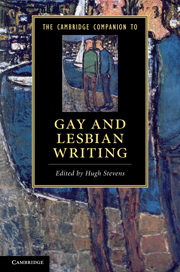Book contents
- Frontmatter
- Homosexuality and literature: an introduction
- Part I Repression and Legitimation
- Part II Affiliations
- 6 The homoerotics of travel: people, ideas, genres
- 7 The queerness of race and same-sex desire
- 8 The literature of AIDS
- 9 Transgender fiction and politics
- Part III Literary Traditions
- Guide to further reading
- Index
7 - The queerness of race and same-sex desire
from Part II - Affiliations
Published online by Cambridge University Press: 28 January 2011
- Frontmatter
- Homosexuality and literature: an introduction
- Part I Repression and Legitimation
- Part II Affiliations
- 6 The homoerotics of travel: people, ideas, genres
- 7 The queerness of race and same-sex desire
- 8 The literature of AIDS
- 9 Transgender fiction and politics
- Part III Literary Traditions
- Guide to further reading
- Index
Summary
The rub between 'race' and 'same-sex desire', as two concepts hotly contested yet frequently wedded, powerfully plays out its frictions in literature. Novels and films are capacious enough, as are poems, to show how fraught is the place where race and queerness cross - between groups of people, inside specific groups, or in individuals - and cross, moreover, at odd, oblique angles. Always, one wonders: what is the logic of how they join? Fictional texts immediately thicken these explanations, forging 'nonce taxonomies' (new, specific, one-time namings) as they help us theorize through the lure of details. A highly credentialled 'Negro' doctor, played by Sidney Poitier in 1967, in Guess Who's Coming to Dinner, becomes a black queer hustler depicted in 1993 by the actor Will Smith. The means of this startling transformation is Six Degrees of Separation, John Guare's 1990 play, written in the midst of the AIDS epidemic, in the early period of queer theorizing. With its spare, staccato lines ('It's awful'; 'I am shaking'; 'You brought this thing into our house!'), its verbal patter (mixing ideas about revolution with Broadway showtunes) and its obvious theme of art as beholden to colour (a 'burst of color asked to carry so much'), Six shows queerness cannily haunting its mainstream model.
- Type
- Chapter
- Information
- The Cambridge Companion to Gay and Lesbian Writing , pp. 116 - 131Publisher: Cambridge University PressPrint publication year: 2010

